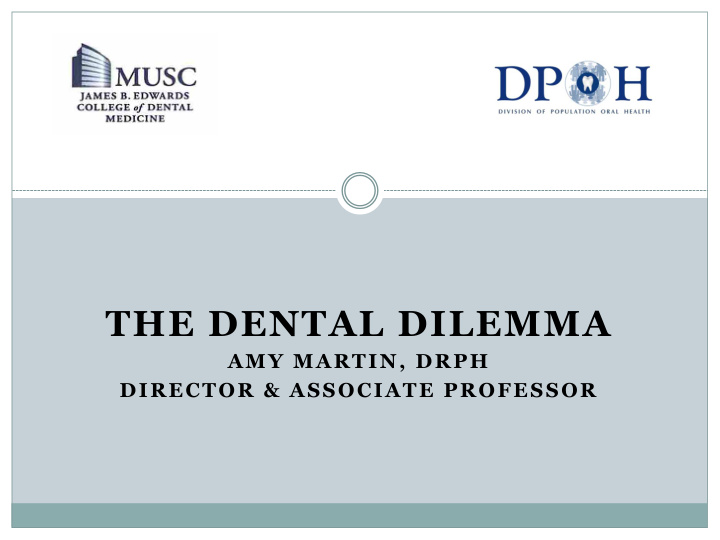



THE DENTAL DILEMMA AMY MARTIN, DRPH DIRECTOR & ASSOCIATE PROFESSOR
Introduction: Rural First! 20 years in rural health Bamberg County Hospital & Nursing Center SC Office of Rural Health SC Rural Health Research Center Appalachian Rural Commission, Health Policy Council White House Rural Council Public Private Partnership Initiative with Grantmakers in Health National Rural Health Association Oral Health Advisory Group
Overview Responsibilities Established in 2014 in Enhance public health 1. learning for dental students Department of Stomatology Conduct health services and 2. Focus on oral health equity population health research for underserved Develop service/outreach 3. populations programs for vulnerable $4.2 million in extramural populations funding Translate clinical research 4. for safety net practice
Overview 1. Scope of the Problem 2. Policy Levers for Addressing Unmet Dental Need 3. Business Case for Integrated Care Models & Interprofessional Practice 4. The Path Forward
Unmet Oral Health Burden for Hospitals ER Visits for Unmet Needs 600+ saliva depleting Rx Memory disorders Substance Abuse Uncontrolled A1c Preterm labor HIV
Another Deamonte Driver Middle-aged woman in Pee Dee Region Presented with fasciitis and sepsis due to untreated abscess Admitted to inpatient bed in September 2016 Death due to sepsis
ADA Health Policy Institute Where Have All the Dental Visits Gone?
Scope of the Problem: How We Rank for Pediatric Access Source: CMS/DentaQuest Institute, 2015 Medicaid
Dental HPSAs Dental access challenges exist Too few DMDs or poor distribution?
Dental Safety Net Capacity Considerations Estimates of Need Pop. Numbers National estimate of underserved 82 million Number that see a dentist annual (27.8%) 22.8 million Current Estimates of Capacity Pop. Numbers Existing capacity at CHCs, hospitals, public schools & 7 to 8 million dental schools Estimates of Capacity Expansion Options Pop. Numbers Expand CHCs & their efficiencies 2.5 million Require dental school grads to receive 1 year of residency training, and senior dental students and residents to work 60 days in community clinics and practices. Bulk of additional capacity needs to come through private practice settings but how do we pay for this? Source: Bailit H et al, 2006
(Limited) Federal Policy Levers Safety Net Investments
NC FQHC Oral Health Expansion Grants
SC FQHC Oral Health Expansion Grants
FQHC Capacity Optimization 80% vs. 20%, medical/dental Understanding partnership opportunities & limitations Need for productivity-based practice culture
The Case for State Policy Levers What are costly diagnoses to your states’ Medicaid programs? ¡ Those who come early… Preemies Huck O, Tenenbaum H, Davideau JL. Relationship between periodontal diseases and preterm birth: recent epidemiological and biological data. Journal of Pregnancy, 2011, Article ID 164654. ¡ Those who live long… Dementia/Alzheimer’s Manczak M, Reddy, PH. Abnormal interaction of oliomeric amyloid-beta with phosphorylated tau: Implications to synaptic disyfunction and neuronal damage. Journal of Alzheimer's Disease 36(2), 2013, DOI:10.3233/JAD-130275. ¡ Those who with chronic disease… Diabetes & Cardiovascular Disease Leite RS, Marlow NM, Fernandes JK. Oral health and type 2 diabetes. American Journal of Medical Science. 2013 Apr;245(4):271-3.
Policy Lever 1: Expansion of Professional Practice Acts Alternative dental hygiene models (e.g. dental hygiene therapists) Safety net practice/supervision for dental hygienists* Non-direct supervision models for dental auxiliaries for preventive services* *Described in , “State Policy Levers for Addressing Preventive Dental Care Disparities for Rural Children,” included in CD and available at http://rhr.sph.sc.edu/report/ State%20Policy%20Levers%20and%20Dental%20Care%20Disparities%20Executive%20Summary.pdf (State-specific data available.)
Beyond RDH General Supervision
Practice Act Impact on Sealants
Policy Lever 2: Medicaid Reimbursement & Administration Competitive dental reimbursement rates Easy to navigate provider enrollment & billing infrastructure Non-dental clinician reimbursement policy for preventive services, e.g. fluoride varnish* ÷ Special considerations for safety net providers such as community health centers and rural health clinics *Described in, “State Policy Levers for Addressing Preventive Dental Care Disparities for Rural Children,” included in CD and available at http://rhr.sph.sc.edu/report/ State%20Policy%20Levers%20and%20Dental%20Care%20Disparities%20Executive%20Summary.pdf (State-specific data available.)
Medicaid Reimbursement & DMD Participation
Policy Lever 3: Recruitment & Retention Programs National Health Service Corp ¡ Encourage FQHC dental expansions & site eligibility ¡ Support outreach & education of students ¡ Connect with State Offices of Rural Health, Primary Care Offices, & Primary Care Associations, State Divisions of Oral Health State-supported loan repayment programs & other incentive packages
The Business Care for Integrated Care Emerging in outpatient settings Best studies (n=3) examine oral health/diabetes management, although limited to privately insured patients. ¡ Savings is actualized from inpatient reductions
Rural Oral Health Equity Portfolio Reduce rural health disparities Enhance oral health for children & high-risk adults interprofessional education for with diabetes primary care & dental graduates Community medical-dental Improved competencies, business integration acumen, & willingness for rural safety net practice Working in 3 rural markets: York, Fairfield, & Orangeburg Counties
The Path Forward South Carolina demonstration projects Emerging model with rural hospital system Partnership mobilization
ROADS Partners
Translating Practice to Pipeline ROADTRIP’s purpose is to transform interprofessional education at the MUSC so that more dental and primary care graduates have the prerequisite clinical and interprofessional competencies, business acumen, and willingness for rural safety net oral health practice. ¡ Graduate-level certificate in safety net dental practice ¡ Integration of oral health competencies campus-wide in health professions Thou shall… 1. Risk assessment programs 2. Patient education 3. Preventive clinical care 4. Referral management
ER Frequent Flyer: An Opportunity Realized 5 ER trips in two weeks for fever of unknown origin Family Medicine Resident inspects the mouth Prior training on oral health risk assessment Appropriate care and referral
New Oral Health Partnership with TDE Focus areas ¡ School-based oral health solutions ¡ Safety net capacity ¡ Integrated care models Research Consortium ¡ Dental schools & Rural Health Research Centers
Thank you! Amy Martin, DrPH Director & Associate Professor martinamy@musc.edu 843-792-8270
Recommend
More recommend